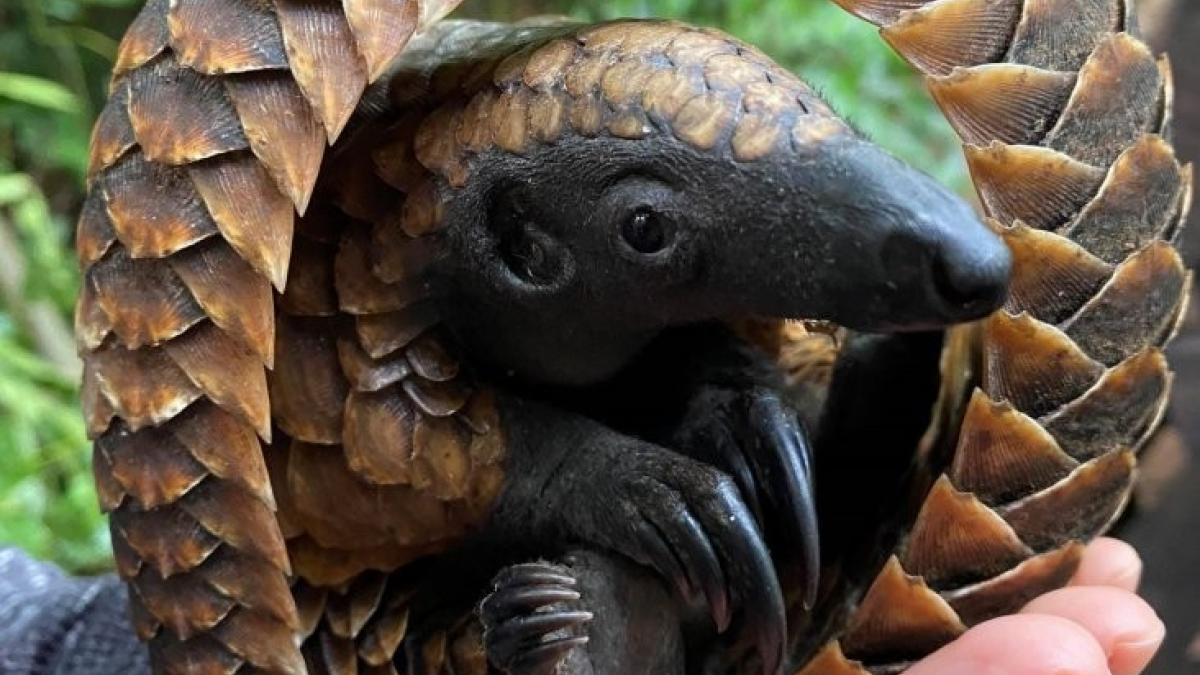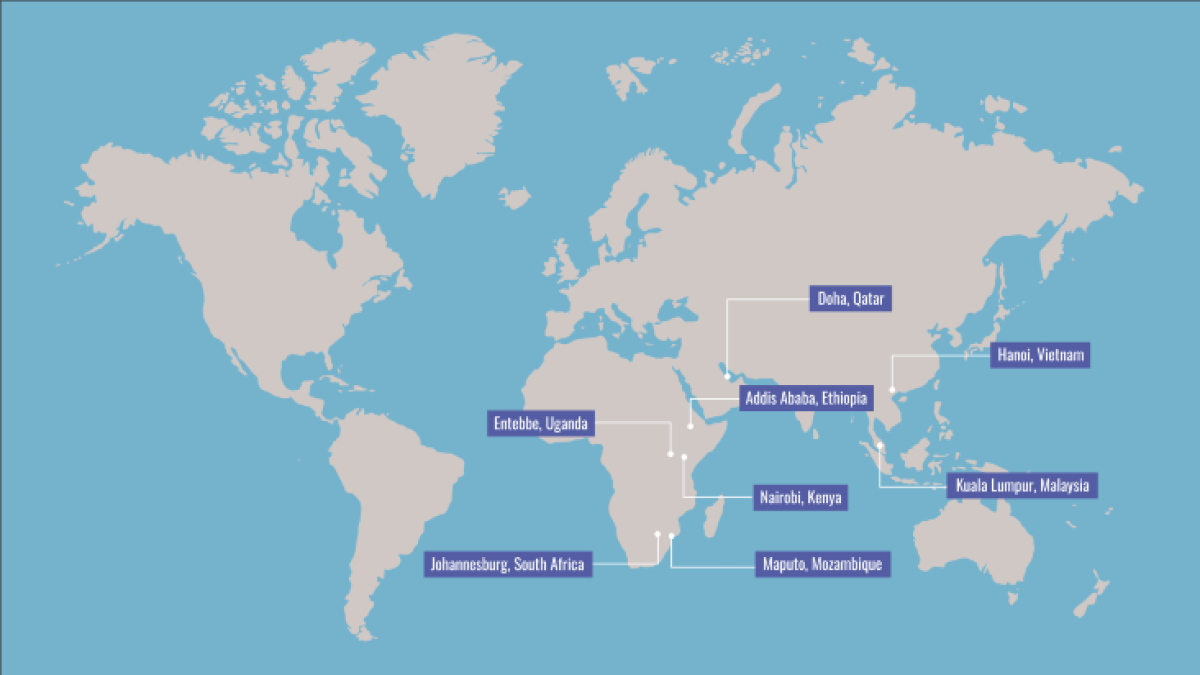
1. Building an evidence base
The illegal wildlife trade is not just a threat to animals and communities dependent on wildlife-friendly livelihoods—it is a threat to the air transport sector. Smuggling of wildlife and wildlife products like live reptiles, elephant ivory, pangolin scales and meat, and rhino horn undermines security, increases corruption, and raises the risk of disease spread across borders.
In 2015, USAID established the Reducing Opportunities for Unlawful Transport of Endangered Species (ROUTES) Partnership to bring together transport and logistics companies, government agencies, law enforcement, and conservation organizations to eliminate wildlife trafficking from the air transport supply chain.
However, it quickly became apparent that very little data and analysis of the problem existed. To solve this, the Center for Advanced Defense Studies, a ROUTES partner, gathered data on publicly reported seizures of key wildlife products to build the first-ever global database on wildlife trafficking in air transport.

This database forms the backbone of the Wildlife Trafficking Data Dashboard that ROUTES launched in May 2019, which enables users to easily create maps and graphics to analyze specific locations, flight routes, transport methods, and trafficked species. A Route Risk Tool was also created to help users pinpoint routes that are at particular risk of exploitation by wildlife traffickers. Data from the dashboard now lives on the TRAFFIC Wildlife Trade Portal so that it can be used well beyond the life of the project. Recently, the Center for Advanced Studies launched a Wildlife Seizure Dashboard to showcase trends in seizures of five frequently-trafficked wildlife categories: elephant ivory, leopard, pangolin, rhino horn, and tiger.
The Partnership also developed five in-depth analysis reports examining wildlife trafficking in different geographies and highlighting linkages with zoonotic disease and other trafficking crimes. These reports have been used by industry and government actors to inform decision-making and target priority regions and strategies for public investment and action.
2. Bridging the gap between industry and law enforcement
Once ROUTES compiled evidence demonstrating the nature and scope of the issue, it turned its efforts towards building awareness within industry associations, such as the Airports Council International (ACI) and the International Air Transport Association (IATA), as well as with individual companies and employees.
Prior to ROUTES, air transport staff, such as cabin crew and baggage screeners, did not have standardized protocols for reporting suspicious wildlife trafficking activities. ROUTES developed solutions to fill this gap and provided tools to improve communications between the sector and law enforcement. Actions included staff training workshops for nine airlines, nine airports, and two ground handling companies—reaching more than 1,600 air transport staff. ROUTES also collaborated with the ACI and IATA to create e-learning courses, which the industry can use to keep its workforce trained and informed of the latest tools and methods to combat wildlife trafficking.
In 2016, IATA and the World Customs Organization co-developed a wildlife trafficking gap assessment tool to identify vulnerabilities to wildlife trafficking within airports. ROUTES carried out these assessments at eight major airports worldwide.

3. Innovating to enhance detection
To further enhance detection, ROUTES supported the development of a reporting app, the Wildlife Sentinel, which empowers air transport staff to anonymously report suspicions of wildlife trafficking. In just two months the app collected more than 120 reports of potential wildlife crime. Crime Stoppers International will maintain the Wildlife Sentinel app for at least two years, translating it into multiple languages, and is exploring ways to integrate it into its platform in the long-term and adapt it for other types of trafficking beyond wildlife. ROUTES also supported the development of an algorithm that can be applied to baggage screening x-ray systems to detect illegal wildlife products, which is now being tested in the field.
4. Finding common ground

Sentinel App, which is available to
Apple and Android users. - TRAFFIC
Perhaps one of the most significant outcomes of the ROUTES Partnership, which will determine whether these efforts are sustained in the years to come, was its ability to bring together different actors with different interests and help them find common ground. With ROUTES’ support and influence, several key aviation industry stakeholders and leading associations, the IATA and ACI, engaged more closely with initiatives and institutions related to wildlife trafficking.
For example, in February 2020, ROUTES and United for Wildlife co-convened a Southern Africa regional workshop in Johannesburg, South Africa to establish a Southern Africa Transport Task Force to combat wildlife trafficking. Since then, multiple regional Task Forces have been established. In August 2021, ROUTES hosted a workshop to bring together stakeholders from Colombia, Ecuador, and Mexico to design country-specific action plans, and facilitated the establishment of Brazilian and Mexican multi-stakeholder working groups.
In July 2021, ROUTES achieved one of the greatest assurances of long-term action against wildlife trafficking to date: the International Civil Aviation Organization Council Facilitation Panel unanimously endorsed a proposal to adopt a recommended practice on wildlife trafficking prevention under the UN Convention on International Civil Aviation. This was later approved by the ICAO Council and will come into effect in July 2022.
ROUTES has also supported companies that signed the Buckingham Palace Declaration to implement strategic actions as part of their pledges to reduce wildlife trafficking in supply chains.
When USAID’s ROUTES Partnership began in 2015, there was little awareness of the nature and scale of wildlife trafficking in the air transport industry. Data was scarce and air transport staff did not necessarily have the intel or resources needed to identify or report suspected wildlife crime. Through the ROUTES Partnership, a suite of evidence, tools, and opportunities for collaboration between the industry and law enforcement were created, paving the way for long-term success as the industry began to institutionalize wildlife trafficking prevention resources. As a result, awareness of wildlife trafficking in the air transport sector has increased substantially, and airlines, airports, and their staff are now active partners in the fight against wildlife crime.
